Jerusalem is an amazing religious and historical destination. It is a pilgrimage destination for Jews, Christians and Muslims. For us personally, it brought the New Testament to life as we walked the streets and visited the sites that were so instrumental in the life of Jesus.
Quick disclosure for our readers. Jerusalem can be a touchy topic for many. This blog post will reflect our impressions of the city and the ways we were touched by what we saw. We won’t explore whether the State of Israel has a legitimate claim to the city.
Biblical history is also fraught with potential to offend. If our descriptions of events don’t match your understanding, please pardon our indulgence.
Jerusalem has a tumultuous history. It has been captured and recaptured 44 times in its 5,000 year history. It has been completely torn to the ground twice. In retaliation for the Jewish Revolt of 66 AD, four years later the Romans destroyed the temple, slaughtered most of the Jewish inhabitants and leveled the entire city. It sat as a pile of stone for about 60 years and the name Jerusalem was stricken from all public records.
It was not until Emperor Constantine, after his conversion to Christianity, rebuilt the city as a Christian center in 335 AD that the name Jerusalem was used again.

We arrived by bus from Tel Aviv in the afternoon. As the bus approached Jerusalem we were a little surprised to see it was such a major city. The suburbs extended for miles. Somehow we were expecting a quaint historic town. We learned later that the population is 857,000.
We checked into the apartment and immediately went for a walk. We were just about half a mile from the old city walls which surround the ancient section of Jerusalem.
The street connecting us to the old city was a wide, modern boulevard serviced by slick, new, electric street cars. Car traffic was not allowed and pedestrians were in abundance. So we followed the flow to the old city.
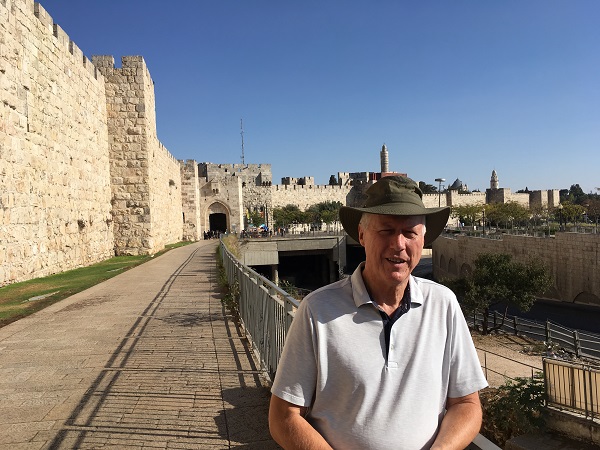
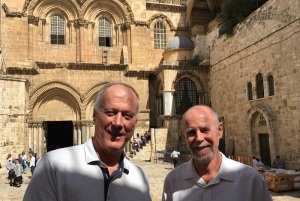 Inside the walls, we headed toward the Church of the Holy Sepulcher – Ground Zero for Christian pilgrims. The original church was built on this site in the year 335 by Helen, the mother of Emperor Constantine, to protect the holiest Christian sites in Jerusalem – the rocky hill where Jesus was crucified and the tomb where his body was laid.
Inside the walls, we headed toward the Church of the Holy Sepulcher – Ground Zero for Christian pilgrims. The original church was built on this site in the year 335 by Helen, the mother of Emperor Constantine, to protect the holiest Christian sites in Jerusalem – the rocky hill where Jesus was crucified and the tomb where his body was laid.
Walking into this church was awe-inspiring. The church is controlled by a variety of different Christian denominations, each being responsible for a different small section. The Armenian Apostolic and Greek Orthodox control over major sections add an exotic flavor and their pilgrims add a fervency that is infectious.
That first night we got our bearings. The next morning we returned early to the church so that we could enter the tomb itself.  We waited in line for about an hour. Within the large church is a small chapel. Within the chapel is the tomb where it is believed Jesus was laid when he was taken from the cross.
We waited in line for about an hour. Within the large church is a small chapel. Within the chapel is the tomb where it is believed Jesus was laid when he was taken from the cross.
At the core of Christianity is the belief that Jesus rose from the dead on the third day after being placed in the tomb.
Once inside the chapel, we had to crouch down to get into a small inner room which contains the tomb. We were allowed to kneel beside the tomb for about a minute before being ushered out. Over a 1,000 years ago a marble slab was placed over the tomb so that visitors would not attempt to take a piece of the rock. But to kneel in this sacred place was an overwhelming spiritual experience. Once we exited, we simply hugged each other and cried.
This was the first of many moving experiences to come during our visit. But let’s mix it up a little.
Dancing in the Street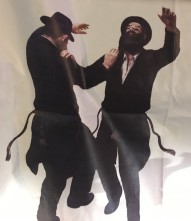
We arrived for our five-day visit in Jerusalem on a Tuesday, at the beginning of the Jewish holiday of Sukkot. The schools are closed for the week. The holiday starts with two high-holy days (Tuesday and Wednesday) where almost all businesses close down, especially after sundown. Fridays are always a day when most businesses close down at sunset.
So on Thursday night, the only break in three holy days, the city was hopping.
 We came across one of the most joyous scenes we have witnessed. A musician on the street was playing what sounded like Jewish rock n’ roll music. All of the lyrics were in Hebrew, and the music had a contagious, pounding beat.
We came across one of the most joyous scenes we have witnessed. A musician on the street was playing what sounded like Jewish rock n’ roll music. All of the lyrics were in Hebrew, and the music had a contagious, pounding beat.
On the street, a group of about 100 males, ranging in ages from eight to eighty, were all dancing with unbridled joy. They all sported yarmulkes, many with more formal, orthodox attire. Most of the dancing was in circles, holding hands or arms around shoulders. The joy and the music were infectious. Women stood around the perimeter, swaying with the music, watching the small children, and taking videos.
The joy made us reflect upon the many holocaust memorials we have seen on our travels in Europe. We could not help but see the joyous dance as a response to the unbelievable and unbearable oppression of the Jewish people.
Here they were, all these men and boys, in a safe Jewish bubble, dancing for joy. The contrast was remarkable.
We periodically seek out all-gay bubbles, such as weekend retreats or gay cruises, so that we can relax in a bubble of our own. We feel completely comfortable outside of the bubble, in the real-world, but we gather strength by occasionally touching base with an environment where we can hold hands or kiss without thinking about the judgment of others. This is the same reason that churches will hold weekend retreats where members of the congregation can talk openly about their beliefs with those of a like-mind.
That night, the creation of a Jewish state felt like a reason to celebrate. What freedom to dance and laugh in the street wearing a Yarmulke. We get that and we shared in the joy for the happy dancers.
Home of Jewish Fashion
The variety of clothes found on the streets of Jerusalem is amazing. Many of the Jewish orthodox sects have their own unique style of garb. In some cases, it dates back centuries ago when some sects declared that styles would not change. It was part of the rich tapestry to be found in Jerusalem.
On the street we found stores selling yarmulkes in every color and design. There were even ones featuring sports team logos.
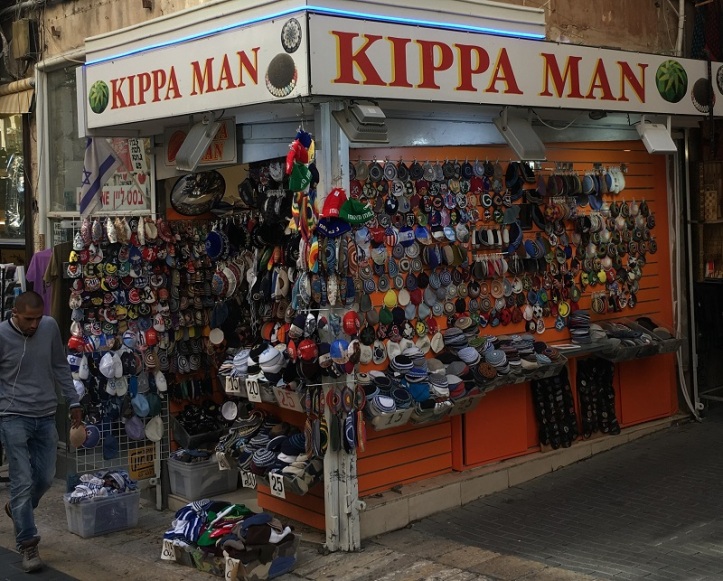
And possibly the most over-the-top yarmulke was one we saw a young boy wearing featuring the McDonald’s logo. He was also drinking a soda from McDonald’s. Maybe it was in a Happy Meal?

Visiting Temple Mount
In the center of Jerusalem there was a huge rock. And when we say huge, we mean that in a lot of ways. Sure it’s big – towering over the city. But there is more.
It is believed that it was upon this rock that Abraham nearly sacrificed his son Isaac. Early Jews believed that this Holy of Holies location marks the spiritual junction of heaven and earth, so they had their temple built here. And for Muslims, it was from this Foundation Stone that Muhammad left the earth and ascended into heaven. So like we said, it’s a “huge” rock.
In the 1st century BC, Herod had four large walls built around the rock and the area within the walls filled with dirt around the base of the rock. This created a large, flat area where he built a massive Jewish temple.
This is the same temple where Jesus boldly kicked over the tables of the money changers. That was certainly a rebellious act that directly challenged the Temple authorities and led to his crucifixion.
The Temple was destroyed by the Romans in 70 AD in retaliation for the Jewish Revolt against Rome four years earlier.
Atop this foundation stone, the Muslims have their oldest mosque, The Dome of the Rock, dating back to 691 AD.

So, all three of the major western religions have claims to this sacred mountain top. 
Today, pilgrims from all three religions have access to Jerusalem and the Temple Mount. For Jews, however, the Mount is so holy that Torah law technically prohibits Jews from walking on portions of the Mount. Instead focus their worship at the Western Wall which provided the foundational support for the mount and the Jewish Temple.
Our visit to the Mount was part of a four-hour walking tour of holy sites within Jerusalem.

The Mount is a high-security location and one where no overt display of religious affiliation is allowed. A member of our tour had to remove her Star of David necklace. Out of respect for the Islamic traditions, the men could not wear shorts and women in our group had to cover their heads and bare shoulders with scarves.
Visit to the the Garden
Immediately outside the walls of old Jerusalem is the Mount of Olives where Jesus delivered his Sermon on the Mount. We walked to the top of the Mount of Olives, which was quite a hike up.

At the base of the Mount of Olives, close to the city walls, is the Garden of Gethsemane where Jesus spent the night in prayer before his capture. This was the place where Judas betrayed Jesus, identifying him for the Roman soldiers. It is the subject of so many beautiful gospel songs and portraits of Jesus praying on the night before his death.
 To stand among the olive trees in this garden brings those stories to life. From the garden one can see the gate where Jesus entered Jerusalem on Palm Sunday, riding on a donkey. He knew he was stirring the pot when he entered the holy city. He certainly asked for trouble when he kicked over the money changing tables, released the sacrificial animals and called out the temple authorities as a “Brood of Vipers.”
To stand among the olive trees in this garden brings those stories to life. From the garden one can see the gate where Jesus entered Jerusalem on Palm Sunday, riding on a donkey. He knew he was stirring the pot when he entered the holy city. He certainly asked for trouble when he kicked over the money changing tables, released the sacrificial animals and called out the temple authorities as a “Brood of Vipers.”
And now here he was, camped in the garden, with a view of the city, waiting for the hammer to fall.
Money Changers Survive
 In a twist of irony, here is a money changer we found immediately inside the the old city walls of Jerusalem. Fortunately, we didn’t see any vipers.
In a twist of irony, here is a money changer we found immediately inside the the old city walls of Jerusalem. Fortunately, we didn’t see any vipers.
Walking the Via Dolorosa
Every Catholic church in the world features the “Stations of the Cross,” fourteen pictures arrayed in order around the inside of the church, depicting the torturous path Jesus endured from his conviction, carrying the cross, crucifixion and death, and finally to burial in the tomb.
Those fourteen Stations all are depictions of actual locations along a series of windy streets in old Jerusalem called Via Dolorosa.
The Franciscan brothers hold a processing down the Via Dolorosa every Friday at 4 PM. We joined as they led pilgrims from countries all over the world along the path walked by Jesus. At each of the designated locations, such as where he may have fallen with the cross, or where he encountered his mother, they would say a prayer in five languages before moving to the next station.

For the final five stations we returned to the Church of the Holy Sepulcher. This is the location where Jesus was stripped of his clothes, nailed to the cross, died on the cross, his body anointed and laid in the tomb.
Was this the exact path taken by Jesus? Is the spot designated at the 7th station where he fell for the second time while carrying the cross? From a pure historical perspective, no, probably not. There have been numerous different designated paths used throughout history. Was he tried and crucified in this immediate area? Yes, absolutely. Are they confident that the rocky outcropping inside the Church of the Holy Sepulcher is where he was crucified? Pretty much. If the path was off by a few dozen meters one way or the other, it made no real difference.
So, as people of faith, following the Brothers as they walked the stations, we let go of any doubts. This small area is truly where it all occurred. We were touched.
To be in Jerusalem is amazing.

Next stops in Israel – floating in the Dead Sea and visiting Masada.















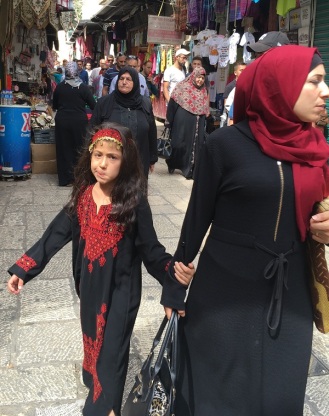
Ah, Jerusalem, a wondrous city of contrasts, joy, and potential danger lurking everywhere. Have spent many happy journeys there, each one fascinating. I prefer it to Tel Aviv.
LikeLike
Wow! Very powerful. Makes me want to go.
LikeLike
[…] Holy Jerusalem […]
LikeLike